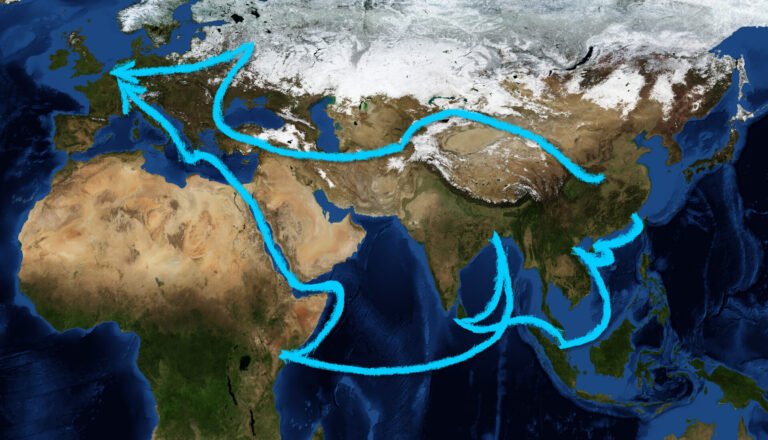Chinese leader Xi Jinping launched One Belt, One Road (OBOR) in 2013, later re-translated as Belt and Road Initiative (BRI), as China’s global infrastructure development strategy for historical Silk Road trading routes. Confusingly, the “belt” refers to land connections, Marco Polo’s northern routes dating from the 13th century; and the “road” to southern Asian maritime expedition routes first established during the Ming dynasty in the early 1400s.

The modern BRI is a peculiar blend of Chinese geopolitics, foreign policy, foreign development aid and investment. Some western cynics see it as neo-colonialist expansion, even extraction. But BRI is also a series of massive engineering commitments, improving transport and energy-related infrastructure in >65 countries at an estimated cost already approaching US$1 trillion and likely to reach US$1.3 trillion by 2027 (according to Morgan Stanley).
This is financed by China, traditionally through its state-controlled banks and financial institutions, usually in the form of loans to the host countries.
While questions on the financing and Chinese motive behind BRI remain unanswered, another issue which makes BRI a sensitive global topic is its impact on the Paris accord, particularly on China’s own green pledges and what it means for the planet.
At the United Nations’ Conference of the Parties (COP21) agreement in Paris in 2015, signatories including China agreed to limit global warming to well below 2OC, preferably below 1.5OC, compared to pre-industrial levels. Countries pledged to reach global peaks of greenhouse gas emissions and then achieve subsequent reductions to achieve ultimate carbon-neutrality – by 2060 in China’s case. It is currently the world’s largest producer of carbon dioxide, c.28% of global emissions. But China has also pledged to reach peak CO2 emissions by 2030; to source 20% of its energy from low-carbon sources and to cut emissions per unit of GDP by over 65% of 2005 levels.
Here lies China’s challenge, and its opportunity. The conflict between the country’s growing green pledges and credentials on the one hand, and heavy engineering and legacy energy projects on the other, is clear. BRI “sustainability” initially just relied on projects satisfying emission and environmental standards in developing host countries; global green responsibilities were delegated. This ignores the separate, but vital, issue of non-BRI deforestation and other climate change hazards. From January 2016 to April 2020, Chinese institutions provided US$15 billion in loans and underwriting services to companies trading in commodities relying on de-forestation in south-east Asia, Brazil and Africa.
Energy projects have been an important component of BRI from the outset. Perhaps one-third of China’s total BRI spending to date, c.US$ 250 billion, has been on energy projects; and >75% of this has involved fossil fuels: mainly coal, then oil and natural gas. There is some hydropower, itself environmentally problematic, but renewables have comprised just a tiny proportion of BRI to date. Has China just been exporting its dirty energy? In one notorious example, China literally disassembled an old coal plant and re-built it in Cambodia. This may help China meet its own national climate pledges, but it’s hardly supporting the spirit of the Paris accord.
Huge engineering projects, even clean ones, conflict with global green ambitions. Cement production is very energy-intensive, even before it’s poured over a felled ancient forest.
Chronologically, BRI (2013) pre-dated COP21 in Paris (2015). Even then, China was not alone in needing time to realise the significance of its climate pledges, whether to “the letter” of its own national pledges or more broadly in “the spirit” of global accord. Lately, the country has re-focused BRI priorities much better to reconcile them with wider green commitments – perhaps hoping to regain some of the moral high ground which BRI, if it had ever held it, had since lost.
A study by China’s Ministry of Ecology and Environment published last December called for a negative list of polluting projects to restrict environmentally harmful projects. It also suggested a separate exclusion list for coal and other fossil fuel energy projects with “severe and irreversible negative impacts”. In March 2021, China’s Embassy to Bangladesh informed the local Ministry of Finance that
“the Chinese side shall no longer consider projects with high pollution and high energy consumption, such as coal mining [and] coal-fired power stations”.
The share of wind, solar and hydropower made up 57%, c.US$11billion, of China’s total investment in infrastructure in 2020, up from 38% in 2019. The pandemic seems to have galvanised several developing countries central to BRI to draw up new plans to ensure their economic recoveries are environmentally friendly – including Egypt, Pakistan, Bangladesh and Vietnam.
2020 was the 3rd hottest year globally ever recorded. The past decade was the hottest in human history. Average temperatures in parts of Siberia are 5OC above their long-term averages. Polar ice caps and mountain glaciers are melting, causing sea levels to rise. Much of Asia is especially vulnerable to the consequences.
China, albeit belatedly, is coming to terms with the reality, complexity and challenge of global climate change; and is accepting responsibility for addressing them. Like western countries and their financial institutions, the various state organs of China are realising all this at different moments and at varying levels of intensity. It’s still piece-meal and awkward. Fortunately for our fragile planet, major Chinese policy makers and key figures including President Xi himself, are among the (newly-)enlightened. Finally, China’s colossal momentum is starting genuinely to support instead of hinder global efforts to slow climate change. With BRI being re-invented accordingly our world might just turn a little greener.

Sumit Dutta is the Founder and Chief Executive Officer of ASEAN Business Partners. Prior to this, Sumit spent 26 years working for HSBC, one of the biggest banks in the world, in countries including Indonesia, Vietnam, USA, Hongkong and India.
Stay up to update with our latest news.
Have Us Contact You
